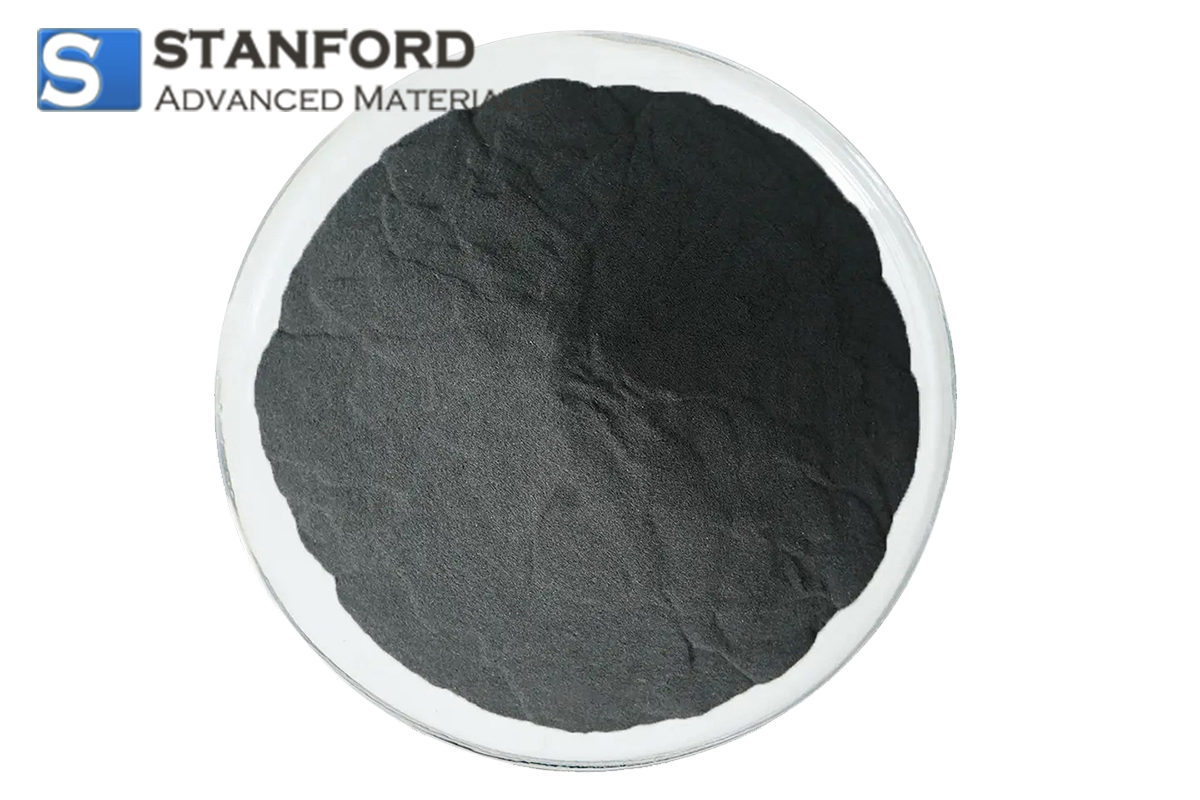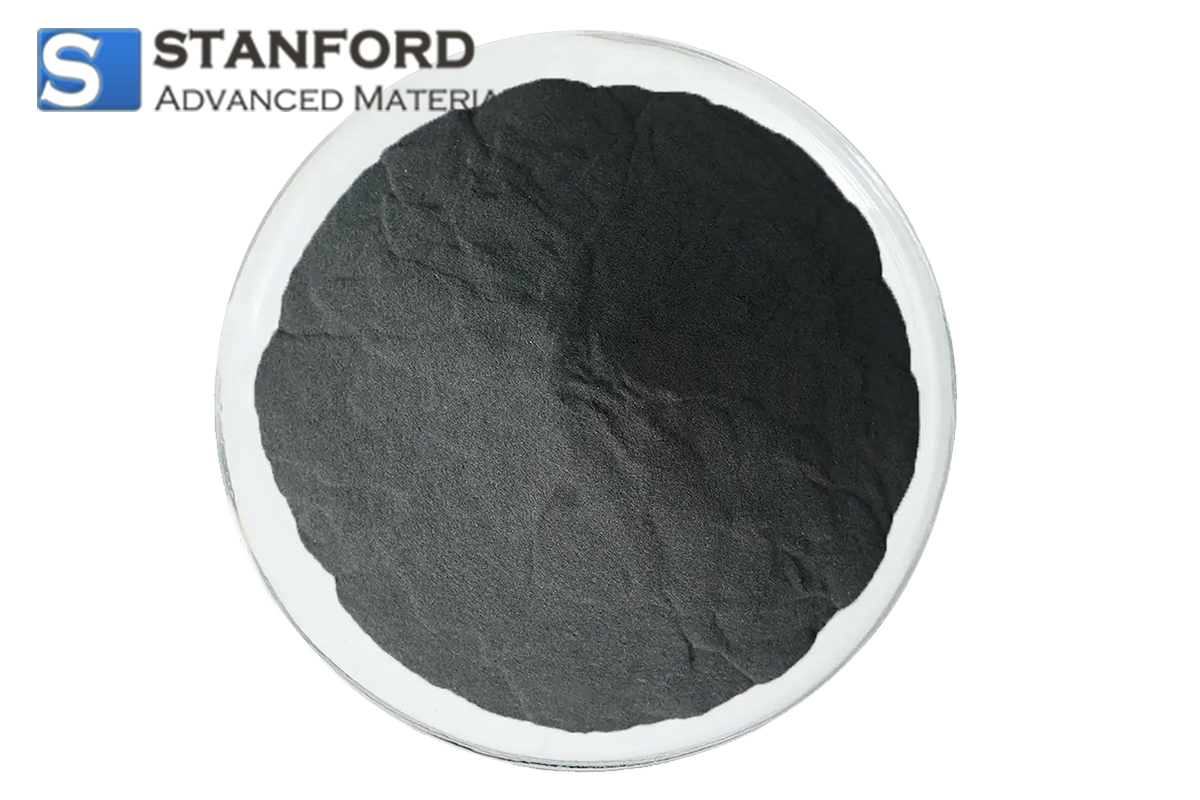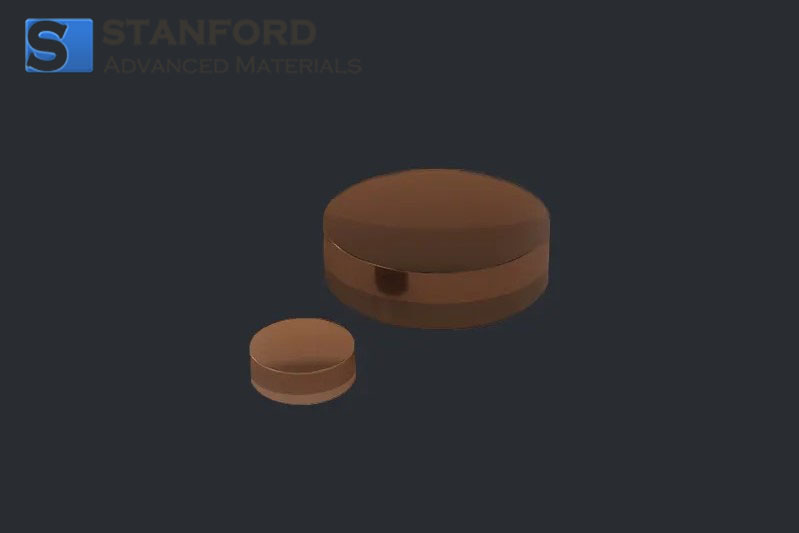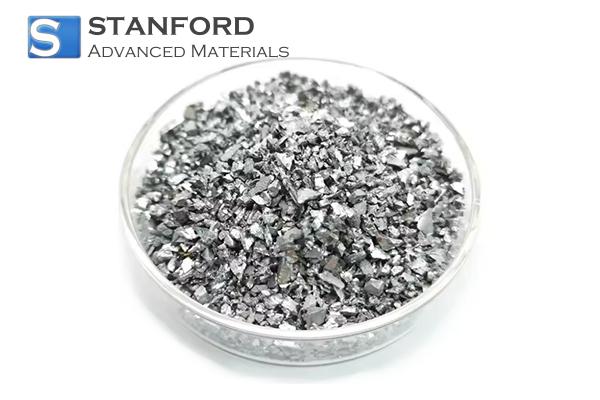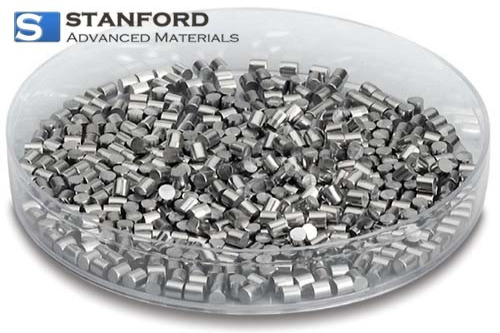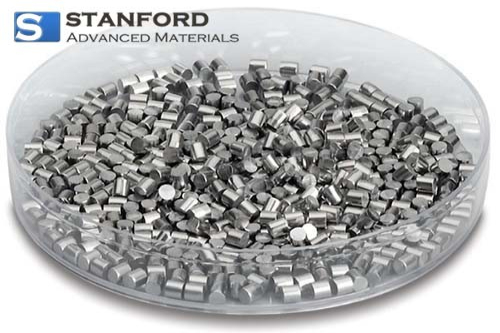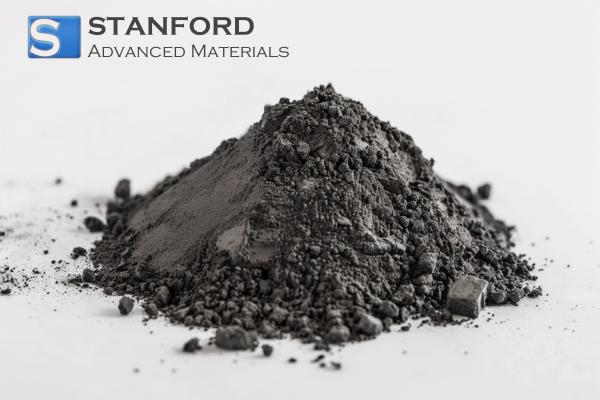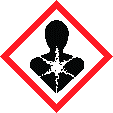SECTION 1. IDENTIFICATION
Product Name: Chromium(III) Boride
CAS #: 12006-79-0
Relevant identified uses of the substance: Scientific research and development
Supplier details:
Stanford Advanced Materials
E-mail: sales@samaterials.com
Tel: (949) 407-8904
Address: 23661 Birtcher Dr., Lake Forest, CA 92630 U.S.A.
SECTION 2. HAZARDS IDENTIFICATION
Classification
This chemical is considered hazardous by the 2012 OSHA Hazard Communication Standard (29 CFR
1910.1200)
Skin Sensitization: Category 1
Carcinogenicity: Category 1A
Label Elements
Signal Word: Danger
Hazard Statements:
May cause an allergic skin reaction
May cause cancer by inhalation
Precautionary Statements
Prevention:
Obtain special instructions before use
Do not handle until all safety precautions have been read and understood
Use personal protective equipment as required
Avoid breathing dust/fume/gas/mist/vapors/sprayContaminated work clothing should not be allowed out of the workplace
Wear protective gloves
Response:
IF exposed or concerned: Get medical attention/advice
Skin:
IF ON SKIN: Wash with plenty of soap and water
If skin irritation or rash occurs: Get medical advice/attention
Wash contaminated clothing before reuse
Storage:
Store locked up
Disposal:
Dispose of contents/container to an approved waste disposal plant
Hazards not otherwise classified (HNOC)
Very toxic to aquatic life with long lasting effects
WARNING. Cancer and Reproductive Harm - https://www.p65warnings.ca.gov/.
SECTION 3. COMPOSITION/INFORMATION ON INGREDIENTS
Component: Chromium boride (CrB)
CAS-No: 12006-79-0
Weight: < 100%
SECTION 4. FIRST AID MEASURES
General Advice:
If symptoms persist, call a physician.
Eye Contact:
Rinse immediately with plenty of water, also under the eyelids, for at least 15 minutes. Get medical
attention.
Skin Contact:
Wash off immediately with plenty of water for at least 15 minutes. If skin irritation persists, call a
physician.
Inhalation:
Move to fresh air. If not breathing, give artificial respiration. Get medical attention if symptoms occur.
Ingestion:
Clean mouth with water and drink afterwards plenty of water. Get medical attention if symptoms occur.
Most important symptoms and effects:
May cause allergic skin reaction. Symptoms of allergic reaction may include rash, itching, swelling,
trouble breathing, tingling of the hands and feet, dizziness, lightheadedness, chest pain, muscle pain
or flushing
Notes to Physician:
Treat symptomatically
SECTION 5. FIREFIGHTING MEASURES
Suitable Extinguishing Media: Not combustible.
Unsuitable Extinguishing Media: No information available
Flash Point: No information available
Method - No information available
Autoignition Temperature: No information availableExplosion Limits
Upper: No data available
Lower: No data available
Sensitivity to Mechanical Impact: No information available
Sensitivity to Static Discharge: No information available
Specific Hazards Arising from the Chemical:
Do not allow run-off from fire fighting to enter drains or water courses.
Hazardous Combustion Products:
Oxides of boron Chromium oxides
Protective Equipment and Precautions for Firefighters:
As in any fire, wear self-contained breathing apparatus pressure-demand, MSHA/NIOSH (approved or
equivalent) and full protective gear.
NFPA
Health: 2
Flammability: 0
Instability: 0
Physical hazards: -
SECTION 6. ACCIDENTAL RELEASE MEASURES
Personal Precautions:
Ensure adequate ventilation. Use personal protective equipment. Avoid dust formation.
Environmental Precautions:
Do not flush into surface water or sanitary sewer system. Do not allow material to contaminate ground
water system. Prevent product from entering drains. Local authorities should be advised if significant
spillages cannot be contained. Should not be released into the environment.
Methods for Containment and CleanUp:
Sweep up or vacuum up spillage and collect in suitable container for disposal. Keep in suitable, closed
containers for disposal.
SECTION 7. HANDLING AND STORAGE
Handling:
Wear personal protective equipment. Ensure adequate ventilation. Do not get in eyes, on skin, or on
clothing. Avoid ingestion and inhalation. Avoid dust formation.
Storage:
Keep containers tightly closed in a dry, cool and well-ventilated place.
SECTION 8. EXPOSURE CONTROLS/PERSONAL PROTECTION
Exposure Guidelines
Component: Chromium boride (CrB)
ACGIH TLV:
OSHA PEL:
NIOSH IDLH: TWA: 0.0002 mg/m3
Mexico OEL (TWA): TWA: 0.5 mg/m3
Engineering Measures:
Ensure adequate ventilation, especially in confined area
Personal Protective Equipment
Eye/face Protection:Wear appropriate protective eyeglasses or chemical safety goggles as described by OSHA's eye and
face protection regulations in 29 CFR 1910.133 or European Standard EN166.
Skin and body protection:
Long sleeved clothing.
Respiratory Protection:
Follow the OSHA respirator regulations found in 29 CFR 1910.134 or European Standard EN 149.
Use a NIOSH/MSHA or European Standard EN 149 approved respirator if exposure limits are
exceeded or if irritation or other symptoms are experienced.
Hygiene Measures:
Handle in accordance with good industrial hygiene and safety practice
SECTION 9. PHYSICAL AND CHEMICAL PROPERTIES
Physical State: Solid
Appearance: No information available
Odor: Odorless
Odor Threshold: No information available
pH: No information available
Melting Point/Range: No data available
Boiling Point/Range: No information available
Flash Point: No information available
Evaporation Rate: Not applicable
Flammability (solid,gas): No information available
Flammability or explosive limits
Upper: No data available
Lower: No data available
Vapor Pressure: No information available
Vapor Density: Not applicable
Specific Gravity: No information available
Solubility: No information available
Partition coefficient; n-octanol/water: No data available
Autoignition Temperature: No information available
Decomposition Temperature: No information available
Viscosity: Not applicable
Molecular Formula: CrB
Molecular Weight: 62.81
SECTION 10. STABILITY AND REACTIVITY
Reactive Hazard:
None known, based on information available
Stability:
Stable under normal conditions.
Conditions to Avoid:
Incompatible products.
Incompatible Materials:
Oxidizing agents
Hazardous Decomposition Products:
Oxides of boron, Chromium oxides
Hazardous Polymerization:
Hazardous polymerization does not occur.Hazardous Reactions:
None under normal processing.
SECTION 11. TOXICOLOGICAL INFORMATION
Acute Toxicity
Product Information
Component Information
Toxicologically Synergistic
Products
No information available
Delayed and immediate effects as well as chronic effects from short and long term exposure
Irritation No information available
Sensitization No information available
Carcinogenicity The table below indicates whether each agency has listed any ingredient as a
carcinogen.
Component: Chromium boride (CrB)
CAS-No: 12006-79-0
IARC: Not listed
NTP: Known
ACGIH: Not listed
OSHA: Not listed
Mexico: A1
Mutagenic Effects: No information available
Reproductive Effects: No information available.
Developmental Effects: No information available.
Teratogenicity: No information available.
STOT - single exposure None known
STOT - repeated exposure None known
Symptoms / effects,both acute and delayed:
Symptoms of allergic reaction may include rash, itching, swelling, trouble breathing, tingling
of the hands and feet, dizziness, lightheadedness, chest pain, muscle pain or flushing
Endocrine Disruptor Information:
No information available
Other Adverse Effects:
The toxicological properties have not been fully investigated.
Aspiration hazard No information available
SECTION 12. ECOLOGICAL INFORMATION
Ecotoxicity
Very toxic to aquatic organisms, may cause long-term adverse effects in the aquatic environment. The
product contains following substances which are hazardous for the environment. May cause long-term
adverse effects in the environment. Do not allow material to contaminate ground water system.
Persistence and Degradability:
Insoluble in water May persist
Bioaccumulation/ Accumulation:
No information available.
Mobility:
Is not likely mobile in the environment due its low water solubility
SECTION 13. DISPOSAL CONSIDERATIONS
Waste Disposal Methods:
Chemical waste generators must determine whether a discarded chemical is classified as a hazardous
waste. Chemical waste generators must also consult local, regional, and national hazardous waste
regulations to ensure complete and accurate classification.
SECTION 14. TRANSPORT INFORMATION
DOT Not regulated
TDG Not regulated
IATA Not regulated
IMDG/IMO Not regulated
SECTION 15. REGULATORY INFORMATION
U.S. Federal Regulations
TSCA 12(b) Not applicable
Component: Chromium boride (CrB)
TSCA 12(b): Section 6
SARA 313
Component: Chromium boride (CrB)
CAS-No: 12006-79-0
Weight: < 100%
SARA 313 - Threshold Values: 0.1 %
CWA (Clean Water Act)
Component: Chromium boride (CrB)
CWA - Hazardous Substances
CWA - Reportable Quantities
CWA - Toxic Pollutants X
CWA - Priority Pollutants
Clean Air Act
Component: Chromium boride (CrB)
HAPS Data: X
Class 1 Ozone Depletors
Class 2 Ozone Depletors
OSHA: Not applicable
Component: Chromium boride (CrB)
Specifically Regulated Chemicals: 5 µg/m3 TWA 2.5 µg/m3 Action Level
Highly Hazardous Chemical
California Proposition 65
Component: Chromium boride (CrB)
CAS-No: 12006-79-0
California Prop 65: Carcinogen
Developmental
Female Reproductive
Male Reproductive
Prop 65 NSRL: 0.001 ug/day
U.S. Department of Transportation
Reportable Quantity (RQ): NDOT Marine Pollutant N
DOT Severe Marine Pollutant N
U.S. Department of Homeland Security
This product does not contain any DHS chemicals. Other International Regulations
Mexico - Grade No information available
SECTION 16. OTHER INFORMATION
Safety Data Sheet according to Regulation (EC) No. 1907/2006 (REACH). The above information is
believed to be correct but does not purport to be all inclusive and shall be used only as a guide. The
information in this document is based on the present state of our knowledge and is applicable to the
product with regard to appropriate safety precautions. It does not represent any guarantee of the
properties of the product.
